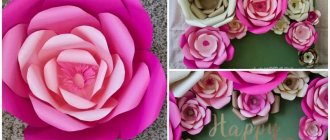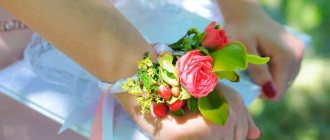Features of the composition
If previously it was believed that the bride must wear an accessory made of fresh flowers, today many replacements have been invented for this solution. Polymer clay allows you to create buds that are indistinguishable from real ones, especially if you practice a little before starting to compose the main composition.
A clay wedding bouquet has several advantages.
- Durability. The bride will be able to keep her wedding accessory for many years; it will decorate the interior without making the decoration tasteless. Instead of the main composition at the end of the wedding, a girl can throw a backup made of fresh flowers to her unmarried girlfriends.
- Ease. A fully assembled bouquet made of polymer clay weighs no more than 300 g, so the bride will be able to move freely throughout the day without fatigue.
- Versatility. From this material you can create any flowers of different shades. A bride can come to a summer wedding with snowdrops, to a winter wedding with irises, etc. Fantasy wedding bouquets made of polymer clay, as in the photo, are very popular among modern brides.
- Advance preparation. Polymer clay never loses its original appearance, so the accessory can be made even several months before the wedding. This frees the bride from additional hassle on her special day.
- Photogenic. In photographs, flowers made from polymer clay look much brighter and more saturated than real flowers.
“Don’t be afraid to create and turn a hobby into a business that generates income”
Admit it, who among you has not dreamed of putting into practice the great testament of Confucius: “Choose a job you like, and you will never have to work a single day in your life”? While some are skeptical about making money from a hobby, the market for handmade goods is expanding and developing at the speed of light. We talked about this with Vladimir polymer clay master Anastasia Zakharova.
— Share how your journey began?
— By education, I am a social teacher with a specialization in “Psychological protection of the population.” I always liked psychology, I was sure that I would become a psychologist and would do only that. Already while defending my diploma, I received an offer to work at the Vladimir Institute for Educational Development in the department of education. I agreed, gave lectures, wrote articles. But, having gone on maternity leave, like many mothers today, I began to look for a way for my creativity, and purely by chance, clay came to hand. In February 2010, I first started sculpting roses, tulips, and leaves. At that time it was a relatively new direction in Russia. People who looked at these works absolutely loved everything, and I thought I was doing cool things. Although now I already see that they are very naive and funny.
— Do you need any special conditions, tools, materials to get started?
— First of all, you need a desire to try polymer clay. It is often compared to plasticine, although these materials have fundamental differences. Clay can vary in softness and structure; each master chooses the one that is convenient to work with. But it is usually baked. For example, I chose exactly this one for myself. However, there are polymer clays that self-harden - marshmallow clay, cold porcelain. They have their own specific subtleties in their work.
Therefore, to begin with, you can take one color and use the tools at hand. Universal ones are a toothpick, many elements can be performed with its help, a stationery knife, instead of a rolling pin you can use a flat bottle, and so on. You don't have to buy everything at once.
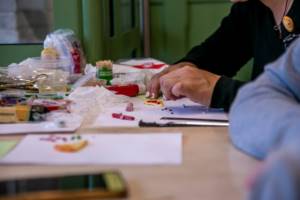
— What inspires you for creative projects?
— To be inspired you need the ability to see around you! Nature is a true inspiration in the creative process. Since childhood, my artist parents taught me to look at the world with special eyes. When friends, also artists, came to visit dad, they could often look with admiration, for example, at a chokeberry bush. Then I wondered - what is beautiful? It's just grass, just leaves. But now, having accumulated some experience in the creative process, I understand them. Now I often look at the sky and notice how beautiful it is, and I want to sculpt something or transfer these waves and airiness into my work. I also look at flowers or stones, people.
One day we were hiking, I saw a frog, and I wanted to replicate its texture on clay, I looked at a friend’s beautiful ear, and it really inspired me. Friends often laugh at this and think I'm crazy. Any moment that exists in nature, what is created by it, everything inspires me. What a person has created, some kind of work, can also motivate, but less so, for me it is already a secondary product.
— What can you make from polymer clay?
- A lot of useful and not very useful things. I try to do work of a practical nature. First of all, the direction of jewelry is widely developed - earrings, bracelets, necklaces, brooches, decorative keychains, interior decor, plant pots, frames.
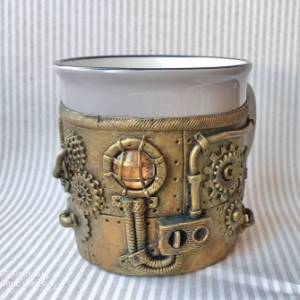
Cold porcelain and marshmallow clay are used to make interior bouquets, bouquets for brides, etc. Doll miniatures, toys, vegetables and fruits for small children are very popular. They make a lot of sweets and dishes for dolls. In the global community, adults collect miniature food. In Vladimir this is not very developed, although I think that the trend will soon reach us.
— Do you have an understanding of what your work is for (besides creative self-expression)? Maybe some created things make life easier?
— I clearly understand why I create them. It brings joy to people! When a girl puts on original earrings, she begins to perceive herself differently, feels confident and calm. And that makes me feel good too. People who receive mugs as a gift, decorated with elements that relate directly to them, begin to perceive such objects in a special way. Our son has a koala spoon. He eats only for her, looks after her and protects her. He appreciates its uniqueness, originality and involvement of himself in this teaspoon. It's just a thing though. It seems to me that work that repeats thoughts, emotions, favorite colors, it lives with the person. Now there are simply too many templates, and we cease to be special. It's important though.
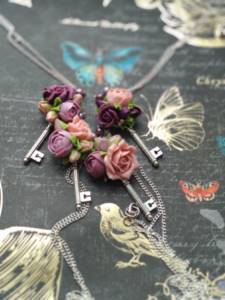
— How long does it take to learn your craft?
- You always need to learn. It is impossible to master a clear base in clay; there are a lot of different techniques and techniques. It’s not worth it - the masters, working with clay, come up with more and more new things. Therefore, the most important thing is to start. Once you start and feel that you like it, it's addictive, you will move forward. As soon as you stopped and considered yourself a master who has nothing more to learn, this is the first call - you need to look at yourself from the other side. The truth is that there is no limit to perfection.
— Working with polymer clay requires a certain budget. How much do the materials cost?
— In fact, this is not exactly a budget option. But everything is relative. Pieces of clay weigh on average 56 grams, and since the works are miniature, everything costs 100-200 rubles. You can buy base colors to mix them. There are masters who work only with white clay and tint it with paints, pastels, and powders. Tools should be purchased as needed. The most expensive (from 800 rubles) is a pasta machine, although to begin with you can buy it for pasta, not clay. If a person is engaged in modeling all the time, then it is better to have a separate oven for baking products (it costs around 4,000 rubles). But, again, a lot can be replaced with improvised means or done yourself.
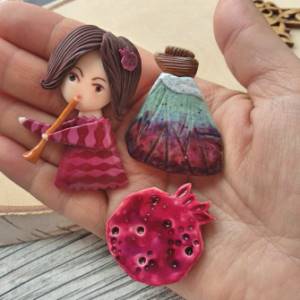
— What can you list the main secrets of a master’s success?
— Now the main secret is not to look at others. A lot of new and old masters are trying to repeat something, to spy on each other. You can observe, but you still shouldn’t copy. It’s always more difficult to come up with ideas, but you still have to find your own style. After all, masters become popular when they are recognized by their work. I think this is one of the important steps to achieving success.
— What should you not be afraid of when starting to work with clay?
- Spoil the material, make a mistake. Without these steps, you cannot achieve a good result. I threw away a lot of products because I didn't like them. Therefore, you need to try, experiment, and then everything will work out.
— What should you do to make fewer mistakes?
— First of all, study the experience of others, master the technique in which you want to work. Also, in no case should you neglect the instructions for the clay itself - how to bake and store it correctly. I strongly recommend that beginners understand this elementary basis.
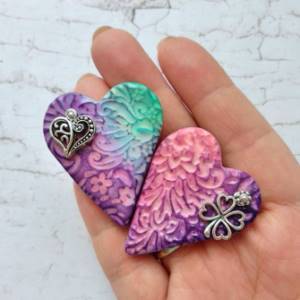
— Tell us about a special product that you are most proud of?
— There are no special products. They are all unique to me, I invest myself in them. But one day, while participating in a New Year's marathon, I created a saucer in the shape of a deer. Then I received a lot of feedback on how cool and unusual it was. I myself was very pleased with him. And there are even masters who have repeated this work using ordinary clay, which we are all accustomed to. Which I was not at all offended by. I just have a wish - to celebrate the fact that I have become a piece of inspiration for you. Although there are masters who are categorically against being copied. By the way, I keep this saucer, although I try to give works from marathons to people so that they bring joy and not gather dust on a shelf.
— How many students do you have? Have they not yet surpassed the teacher?
— I don’t have regular students. There are after-school classes in private kindergartens. In the summer I work at a camp, I lead a modeling group, where about 40 people come to see me every day. And every day there are 2-4 children with excellent data. If they don’t quit, I will have wonderful young colleagues. There is a desire to open a modeling school, where children and adults of any gender (men, by the way, are very good at sculpting even flowers) will not just come to sculpt, but will take a basic course in techniques for working with polymer clay. So that this is not a single master class, but a certain level of skill. I would love to work together with such students. In general, I am always ready to introduce anyone to polymer clay.
— Is selling products more of a nice bonus or good income for you?
“I want to translate my creativity and develop it into something more serious than custom sculpting. Is it possible to make money like this? Of course yes. Sources in this direction are not only the creation and sale of products, but also the holding of master classes, meetings, exhibitions, and online broadcasts.
— Are there many platforms today where a master can share his creativity? Or is Instagram quite enough?
— Today, Instagram is a powerful trading platform. But there are also sites where a huge number of needlewomen are collected. There are opportunities; there would be a desire and ability to create something stylish, unique, inimitable.

— Please give advice to others on how to turn their favorite hobby into a business?
— First, you need to understand whether you really want to pursue your hobby seriously. Can you build your work like a real deal? Secondly, you need to constantly learn and implement your knowledge.
— How far can you go by developing a business in this area?
— Polymer clay is a very positive area for entrepreneurship in the modern world. I repeat, with it you can develop online schools, courses, master classes, and channels on social networks. And today this is a separate phase of doing business, which is more effective than offline. Investors are even more often looking at online projects. So you shouldn’t be afraid to create and turn your hobby into a business that generates income. Moreover, in our region this direction is still quite poorly developed, although new creative workshops are still opening around.

Fortune Teller
According to the old Slavic tradition, the girl had to keep not only the wedding dress, but also the bouquet in the family, after drying it. Tamara Solntseva
This composition will be symbolic for the wedding. The bride does not have to bother with the herbarium; just put the accessory in a decorative vase.
Interesting! Another interesting option to make a realistic bridal bouquet without fresh flowers is to use fabric when creating it.
Compatibility with the style of the celebration
Since you can mold anything that comes to mind from polymer clay, such a bouquet will suit any wedding style. For a classic celebration, the composition is made up of standard plants - roses, lilies, orchids or callas, all of which can be fashioned from pliable material. In this case, you can give the composition any shape, but a hemispherical one will look most harmonious. Wildflowers made from polymer clay are suitable for celebrations in boho, rustic or country style.
Artificial lavender will be useful for a Provence-themed wedding, since fresh flowers can be expensive. For a vintage wedding or shabby chic decoration, roses, peonies and eustomas are suitable.
You can create not only flowers from polymer clay - you can make all additional accessories yourself. For example, for a nautical wedding they sculpt shells, starfish, skates, anchors, steering wheels, etc., for a steampunk style - gears, nuts, bolts, springs and other mechanical parts. Even pearls and decorative greenery can be made from this material to complement the composition.
DIY composition
If the bride decides to create an accessory from polymer clay herself, she will need to purchase the necessary materials. You need to buy self-hardening plastic in the desired shades - these are the future flowers.
In addition to this, you will need wire, oil paints or pastels, glue, wooden sticks (stacks) and scissors. You may also need molds for cutting out finished blanks (cutters) and templates for imprinting the texture of the petals. All this is sold in craft stores.

A beginner can make the following flowers from polymer clay:
- chamomile;
- roses;
- peonies;
- callas;
- orchids;
- lilies;
- daffodils.
A bouquet of daisies will look original in the hands of the bride. To make it, you will need white, green and yellow clay, as well as all the tools listed. First, the wire is covered with a layer of green plastic - this is the future stem. One end of it needs to be bent into a small loop so that the tip is directed to the side.
To create the core, you will need to roll two small balls of yellow and green clay, place the first on the second and press through a small piece of tulle to create the desired texture. Excess edges are trimmed with small scissors.
After this, the petals are made - two inflorescences are cut out of white clay using a cutter. Veins are made on one of them using a wooden stick, and the edges are torn off a little to create barely noticeable teeth at the tips. The petals are torn off from the second workpiece, processed using a stack and attached to the first in a suitable order, after which they are fixed on the stem. All elements are left until completely dry.
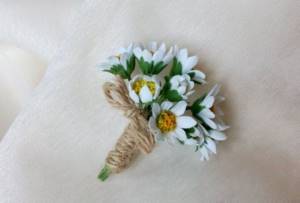
At the next stage, the core is glued to the center of the inflorescence. A receptacle is molded from green clay, which is attached to the bottom of the chamomile. You can give it the desired texture if you randomly make cuts 1-2 mm long with scissors. A leaf is made from plastic of the same color using an appropriate shape, which is attached to the stem.
The flower is left until completely dry and, if necessary, painted over. Ready-made daisies are attached to a hemispherical foam base with a handle, which is decorated with a satin ribbon.
Polymer clay
This is a plastic material intended for modeling. It is easier to work with than pottery, so even novice “sculptors” can sculpt with it. Manufacturers use PVC as the basis of the composition, and to “harden” they add plasticizers to it (due to them, the finished figure keeps its solid shape).
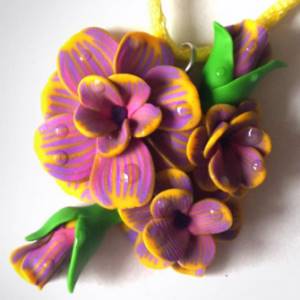
Ready
On sale you will find many brands of clay manufacturers: from classic to advanced. Note that the material can be baked or self-hardening, colored or white: here you will have to focus on your own capabilities and wishes.
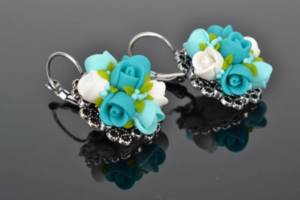
Do it yourself
You can make clay with your own hands. In terms of quality, it will, of course, be inferior to the purchased one. But, if this is your first experience in sculpting, and you are not sure of the outcome of the enterprise, but are eager to try, then this option is suitable and will not affect the budget. So, you will need:
- starch – 100g;
- PVA glue – 100g;
- lemon juice – 2 tbsp. spoons;
- hand cream – 1 teaspoon;
- liquid baby oil - 2 teaspoons.
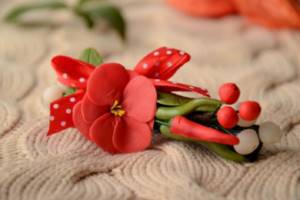
Let's start combining the ingredients: you need to thoroughly stir the components in the container with a spatula and place it in a water bath. Stirring constantly, bring the mixture to a paste, remove from heat, stir again and cool. The finished clay is stored in a plastic bag in a cool place.
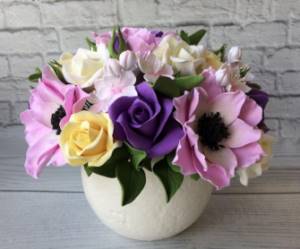
Additional Tips
In addition to her own bouquet, the bride can make a boutonniere for the groom or wrist flowers for the bridesmaids from polymer clay. You can decorate champagne glasses and ring cushions with matching accessories. Accessories on tables can also be made from this material in advance to save on fresh flowers. However, it is not recommended to make a stand-in bouquet from polymer clay, as it will be fragile.
Creating a bridal floral arrangement from self-hardening plastic is a fascinating process. The girl will be able to have a good time and at the same time create her own image, put her own individuality and imagination into it. A handmade bouquet, indistinguishable from the real thing, will definitely be appreciated by the groom and guests.
Anastasia Belozerova
Wedding planner
Previous article
How people celebrated a wedding in Rus': Russian wedding traditions and customs
Next article
Material
So what is polymer clay? In handicraft stores it can also be found under such names as plastic or cold ceramics. Polymer clay is a plastic material consisting of a polymer such as polyvinyl chloride.
Due to the properties of different types of this polymer, plastic is divided into 2 types: baked and self-hardening. The first type of plastic requires heat treatment at a temperature of 100-130 ̊ C. Self-hardening clay does not require heat treatment and hardens at room temperature.
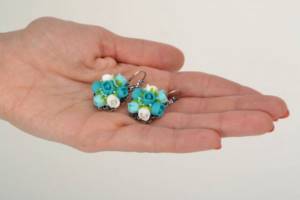
Also, similar clay is divided into 3 more types: heavy and light plastic, as well as cold porcelain.
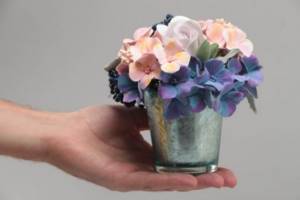
Heavy plastic after drying resembles natural clay and is used only for the manufacture of massive products.
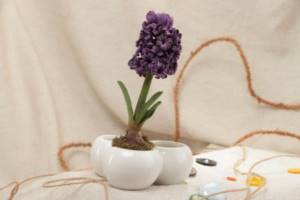
Light clay rolls out well into thin layers and has a delicate consistency, which allows it to be used for more delicate work.
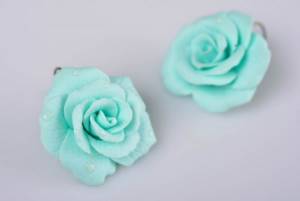
Cold porcelain was specially created for making artificial flowers. Plants made from this type of plastic have a very natural appearance due to the consistency of the material, its plasticity and flexibility.
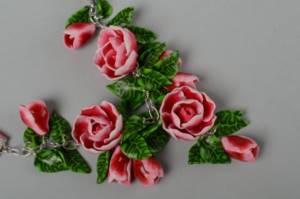
Before purchasing polymer clay, you must clearly determine for which products the material will be used. Afterwards, study the pack of the selected plastic - it will contain instructions describing the work for beginners. It will help you understand which of the plastics in front of you is baked or self-hardening.
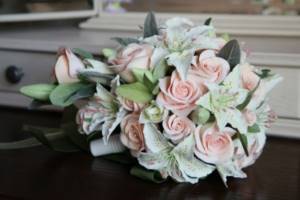
Before purchasing, be sure to check the shelf life of the plastic and the integrity of the packaging. Material with an expired expiration date or damaged packaging quickly loses its elasticity and becomes unsuitable for use.
